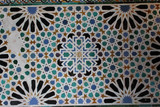
As ceramic tile artists living the south of Spain, we're spoiled for inspiration. Not only do we have mountains, beaches and areas of natural beauty on our doorstep, we're also spoiled with architecture. Just a two hour drive away from our workshop in San Pedro, near Marbella, lies the majestic Alhambra, a palace complex described as a "pearl set in emeralds" by Moorish poets.
We wanted to share with you a snapshot of the architectural artwork we captured on a recent trip and explain how the historical Islamic design plays a part in our own Moroccan wall art and ceramic tiles. To see our Moroccan inspired collection, visit our Moroccan Tile Collection
Considered as one of the most famous examples of Islamic art and architecture, the Alhambra is a sprawling palace, reclining on the hills in Granada, Andalucia. Originally constructed as a small fortress, the ruins were rebuilt in the 13th century by the Moorish emir Mohammed ben Al-Ahmar, and converted to a palace in 1333 by the then Sultan of Granada. The palace complex and garden surrounds kept the surrounding mountains in mind. The lush park is filled with the sound of running water from various fountains and the dense woodland has attracted choruses of birdsong.


The characteristic of the Alhambra which most catches our attention, is the intricate interior. The palace and its surrounds is lavishly decorated with carvings and tile patterns, combining together into a feast for the eyes. Much of the work is carved into plaster, creating light and shadow in the relief, much as we create at G Vega in our tilework.

The Alhambra is heavily studded with geometric shapes and patterns, typical of Islamic art and architecture. The tile mosaics form complex mathematical patterns, winding around the pillars, scattering the ceilings and adorning the walls. The geometric shapes and detailed patterns so typical of Islamic art were also seen in the late years of Roman and Greek art, but Islamic artists took key elements from tradition and elaborated them, inventing a new type of decoration symbolising order and unity. The contributions from scientists and mathematicians were essential to the designs also. Beginning with a simple circle, the square, geometrical designs were layered and duplicated, added with repetitive motifs to create intricate combinations. There are four basic shapes within the movement; circles, with interlaced circles, squares, the star pattern which comes from squares and triangles inscribed in a circle and multi sided polygons.
The tiles pictured in the Alhambra mainly feature within the palace, where bigger was always better. Patterns and colours adorn most of the walls and despite the fading of colour in much of the tilework, the overall effect is still breath taking. Colour is used generously, favouring blues and yellows. It's very possible to imagine a Sultan addressing his court with this ornate decoration running over the walls in the background.

Much of the tilework within the Alhambra mixes Arabic writing with the design. Some of these epigraphic embellishments are poems referring to the place, or to the 13th century Sultan who commissioned the design and architectural work. Some of the writing includes quotes from the Koran.



We used similar geometrical shapes and patterns in our Moroccan collection. Carving into the clay to create relief, similar to the way light and shade is used in the Alhambra, our tilework is quite unique within current ceramic art. Each of our tiles is hand carved, painted and then glazed individually, so each one is truly unique. In our Moroccan collection, we have ceramic tiles in our typical and well known turquoise palate, as well as newer collections in blue and white, silver and beige.
The designs can also be incorporated into bespoke work - read another blog post to see how we designed and installed the decoration on four Moroccan style fountains.

